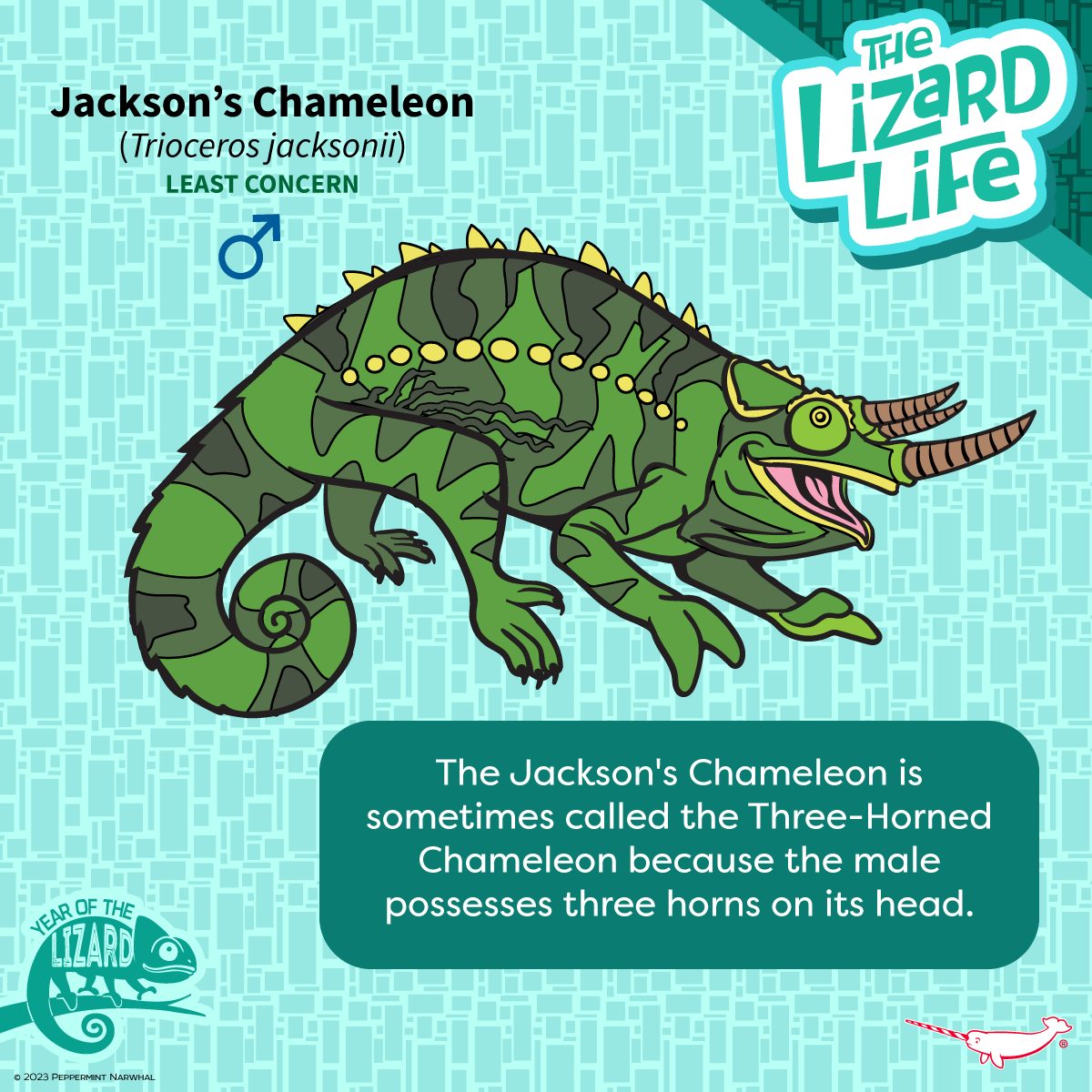– **Discovery and Distribution**: Explore the unique habitats of Jackson’s Chameleon, from the lush forests of Kenya and Tanzania to backyards worldwide.
– **Physical Marvels**: Learn about the distinctive three horns of the male Jackson’s Chameleon and other physiological wonders that set this species apart.
– **Diet and Predation**: Dive into the dietary habits of these creatures and how their eating manner contributes to their survival.
– **Reproduction and Life Cycle**: Uncover the fascinating lifecycle of the Jackson’s Chameleon, from birth to adulthood.
– **Conservation and Care**: Discuss the efforts to conserve the Jackson’s Chameleon and tips for those looking to care for these lizards at home.
Welcome to the Year of the Lizard, an enchanting time to celebrate one of nature’s most splendid and colorful creations—the lizard. Today, let’s zoom in on a particularly captivating member of the lizard family, the Jackson’s Chameleon (Trioceros jacksonii). With its intricate adornments and vibrant hues, this creature resembles something out of a fantasy novel. Often referred to as the Three-Horned Chameleon, it’s reminiscent of a tiny dinosaur or a miniature triceratops traveling through the underbrush of its forest home.
**Discovery and Distribution: A Journey from African Forests to Global Gardens**
Rooted in Kenya and Tanzania’s verdant, misty highlands, the Jackson’s Chameleon was first described in the late 19th century. It’s a species that thrives in cool, humid environments, making the montane forests of East Africa an ideal habitat. However, their adaptability and the exotic pet trade have facilitated their transition to different climates globally, particularly in the United States.
**Physical Marvels: Horns, Hues, and More**
At first glance, Jackson’s Chameleon captivates the observer with the male’s iconic tri-horn setup—a large rostral horn flanked by two smaller supraorbital horns. Not merely decorative, these horns play a critical role in their mating rituals and territorial disputes. Their body, encompassed in a scaly embrace, can undergo color changes reflecting their mood, health, and environmental heat and light levels.
Their zygodactylous feet, with two toes pointing forward and two backward, enable a gripping facility that’s second to none, perfect for their arboreal lifestyle. And let’s not overlook their tongue—a ballistic marvel capable of extending at breakneck speed to snatch prey from a distance.
**Diet and Predation: The Arboreal Hunter**
The Jackson’s Chameleon primarily indulges in an insectivorous banquet. They can target unsuspecting insects from a distance using their unique tongue mechanics. This hunting strategy displays their adeptness and minimizes the energy expenditure required to nourish themselves.
**Reproduction and Life Cycle: A Continuous Cycle of Wonder**
Jackson’s Chameleons exhibit viviparity, a rarity among reptiles, where they give birth to live young instead of laying eggs. Gestation can last five to six months, culminating in the birth of 8 to 30 miniature chameleons. These young are independent from birth, venturing into the world with their innate instincts and camouflage abilities for protection.
**Conservation and Care: Preserving Nature’s Masterpiece**
With their growing popularity in the exotic pet market, it’s crucial to understand the responsibility of caring for these creatures. Proper habitat, diet, and humidity levels are essential for their well-being in captivity. Conservation efforts are also vital to ensure their survival, focusing on habitat preservation and mitigating illegal trade practices.
As we delve into the Year of the Lizard, let’s take this journey as an opportunity to marvel at the natural world’s artistic brilliance. The Jackson’s Chameleon, with its prehistoric charm and fascinating behaviors, is a vivid reminder of our planet’s diversity and the importance of conserving these natural wonders.
Whether you’re a seasoned herpetologist, an enthusiastic pet keeper, or simply someone who appreciates the delicate balance of our ecosystem, the story of Jackson’s Chameleon is a testament to the beauty and complexity of life. Let’s carry this appreciation throughout the Year of the Lizard, fostering curiosity and respect for these remarkable reptiles and the many other lizard species that share our world.
What lizard would you like us to spotlight next? Jump into the comments below with your suggestions. Our journey into the realm of scales and tales is just beginning, and there’s no telling where these scaly paths will lead us next.
Remember, no matter how small or seemingly odd, each creature holds a story worth telling, a life worth celebrating. So, as you venture through your day, take a moment to appreciate the little things, the tiny wonders underfoot, and the vibrant lives flitting from branch to branch in our magnificent tapestry of biodiversity.
Until our next adventure, keep your eyes peeled, your hearts open, and your curiosity boundless. There’s a world of wonder, and it’s ours to explore, understand, and safeguard.
—
Do you have your explorer’s hat ready? We can’t wait to see where this Year of the Lizard will take us. Keep following along, and don’t forget to swing by our shop at Peppermint Narwhal to grab your gear for the journey ahead. Happy exploring!
*****
Source Description
The Lizard Life – The Jackson’s Chameleon (Trioceros jacksonii) is sometimes called the Three-Horned Chameleon because the male has three horns.
Happy Year of the Lizard!
Peppermint Narwhal has declared 2024 the Year of the Lizard. Stay connected with us all year round for lizard spotlights like this one. Feel free to suggest a future lizard to spotlight in the comments. We will do our best to include it in this year’s celebration.
Shop www.peppermintnarwhal.com


